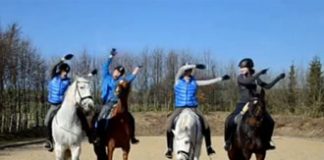
Learning to lift correctly and developing the right muscles will improve your riding, reduce your risk of injury and make barn chores easier.
Riding horses is your life. You live and breathe horses and spend endless hours with them at the barn. But have you ever wanted to test the waters of another sport? Or perhaps you‘ve been looking for something to help you stay in shape out of the saddle and, in turn, improve your riding fitness.
So what are some of the best cross-training sports for riders? We invite you to try some of these and see what might be the best fit for you.
CrossFit for Equestrians
CrossFit is a sport that’s grown in popularity through the years. It’s based on functional fitness, meaning the exercises you do are designed to help you in your every day life. For horse owners, this can translate to the work you do in the barn.
Madi Rohl is a horse owner, veterinary student at Ohio State University, and a certified Level 1 CrossFit coach based in Columbus, Ohio. After spending years in the saddle, she started adding the sport of CrossFit to her daily routine to help her not only be stronger in the saddle, but also in the barn.
“Most horse people experience horses in ways that are not limited to riding,” she says. “We have to be able to groom, tack, carry water buckets and hay bales, and muck stalls. There’s no doubt in my mind that CrossFit helps with those skills.”
Weightlifting moves such as the deadlift and clean are akin to picking up grain bags and hay bales. The clean and jerk combination mimics putting a saddle on your horse. The overall cardio fitness you gain from high-paced WODs (workouts of the day) can help you tackle a grueling cross-country course.
“Another thing people often overlook is mobility and flexibility, which are key parts of CrossFit and are constantly called upon when riding,” says Rohl. “A lot of riders may not think they need to be flexible, but what about putting your heels down? That requires ankle dorsiflexion. Swinging your leg up over the back of a horse to get in the saddle requires some degree of hip mobility and core strength. A lot of CrossFit warm up and mobility exercises include hamstring stretches. Just doing a proper air squat below parallel can be a stretch for some.
“By nature, CrossFit brings out confidence in people, and confidence is something that all good riders must have,” she adds.
Rock Climbing
What does conquering heights and powering over mountains have to do with horseback riding? When you’re riding, you’re using your core (stomach, back) muscles for stability and balance in the saddle. When you’re rock climbing, you’re using those same core muscles, without the wear and tear on your joints that sports like running can inflect, says Bridget Braden-Olson of BioRider Fitness.
“Horseback riders tend to lack muscular stamina in the forearms, upper back and feet, which are all areas that rock climbing targets,” she explains. “Rock climbing also requires full body support and carriage, similar to riding horses.”
Using that full body support and carriage also mimics a rider’s movement in the saddle, because equestrians must support their own bodyweight on a horse. Not to mention the strength gained in the upper back and forearm areas can help when handling a tough horse on the ground as well as when stripping stalls.
Swimming
So maybe some sports, such as rock climbing and CrossFit, might be a little overwhelming to try at first. Or maybe you’re looking for something that’s a little easier on the joints. That’s one of the perks of swimming, because it’s for all ages and it’s one of the best overall body conditioning sports.
The water creates a stronger resistance than air, which will improve muscle strength and tone. Olympic swimming medalist Janet Evans points out in her book Total Swimming that when strokes are performed correctly, the muscles lengthen and increase in flexibility. When you’re swimming constantly, the repetition of the strokes will improve muscle endurance.
Swimming encourages mindful breathing, which is imperative in the saddle.
Combine a couple more sports with swimming, and you have a triathlon, which is seen as the ultimate in cardio fitness, stamina, and leg strength.
Whatever sport you choose to do outside of the arena, it’s always fun to shake things up a bit. While we all know horseback riding is an exercise and a sport in itself, who doesn’t want to be stronger and healthier out of the saddle to improve their riding while in it?
Megan Arszman is a freelance writer based in Indiana, where she’s learning to balance motherhood with horses, dogs and writing.
Read the rest of this article in the January 2016 issue of Horse Illustrated magazine. Click here to subscribe!







than you for this Abigail! sadly we do not have a horse community here in our area and i would love to try those!
Great work. Very well written and informative content.
Nice! The training seems hard but It also helps your body build stamina.